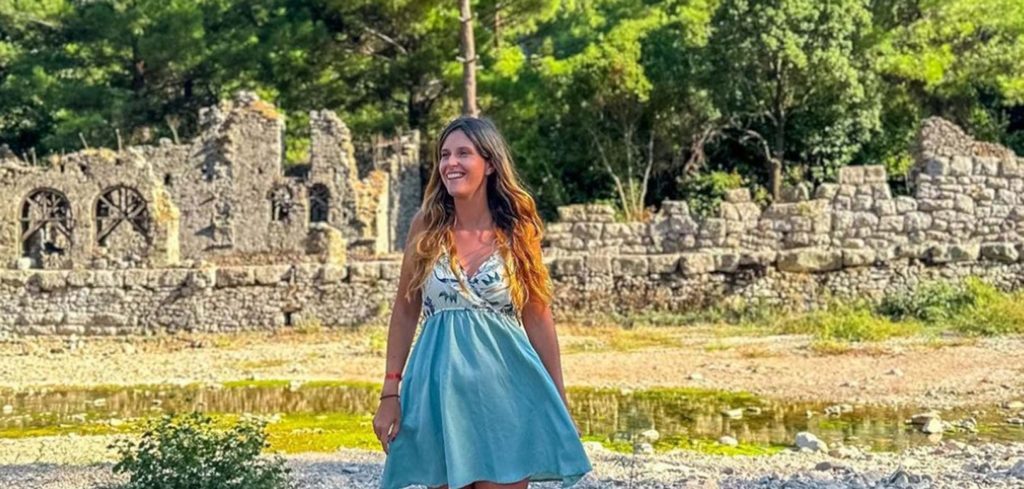Phaselis, an ancient Lycian city nestled along the Mediterranean coast, exudes an enchanting blend of historical significance and natural beauty. The site comprises well-preserved ruins amidst stunning natural surroundings, captivating travelers with its allure.
Historical Significance and Ruins
Phaselis was once a bustling harbor city, renowned for its strategic location and thriving trade. Founded by the Greeks in the 7th century BC, it flourished under various empires, including the Persian, Roman, and Byzantine periods. The city’s three harbors were vital for commerce, and its ruins still showcase remnants of a prosperous past.
Getting to Phaselis
Absolutely! Here’s an expanded version discussing the directions and transport options to Phaselis, comparing various travel methods such as car, public transport, and tours. Additionally, I’ll delve into personal experiences, highlighting the advantages and drawbacks of these options based on firsthand encounters.
Directions and Transport Options
1. Car Travel
Description: Renting a car offers flexibility and autonomy. The drive from Antalya to Phaselis typically takes around an hour, traversing picturesque landscapes along the coastline.
Advantages: Control over the itinerary, ability to explore surrounding areas at leisure, and convenience in reaching off-the-beaten-path spots.
Drawbacks: Parking might be limited or crowded during peak seasons, and navigating unfamiliar roads could be challenging for some travelers.
2. Public Transport
Description: Public buses operate between Antalya and Phaselis, providing a cost-effective option. However, buses might not directly reach the archaeological site, requiring additional walking or taxi rides.
Advantages: Cost-effective travel option, chance to interact with locals during the journey, and availability of scheduled routes.
Drawbacks: Limited schedules might not align with preferred visit times, and the need for additional transportation to reach the site might add complexity.
3. Guided Tours
Description: Joining a guided tour presents a hassle-free option. Many tours include transportation, offering a comprehensive experience with a knowledgeable guide.
Advantages: Convenience, access to expert insights about Phaselis’s history, and the inclusion of other attractions or historical sites in the itinerary.
Drawbacks: Limited flexibility in exploring at one’s pace, potential crowdedness during peak tourist seasons, and adherence to a set schedule.
Personal Comparison
Car Travel Experience

Advantages: Personal autonomy and the freedom to explore nearby attractions like hidden beaches or viewpoints along the way.
Drawbacks: Parking challenges, particularly during peak seasons, and occasional difficulty in navigating narrow or unfamiliar roads.
Public Transport Experience
Advantages: Cost-effectiveness and the opportunity to observe local life during the journey.
Drawbacks: Potential inconvenience in coordinating additional transportation to reach Phaselis from the bus stop.
Guided Tour Experience
Advantages: Expert guidance providing in-depth historical context, hassle-free transportation, and the opportunity to cover multiple attractions.
Drawbacks: Limited flexibility in choosing the pace or exploring specific areas of interest independently.
Each travel option presents unique advantages and drawbacks, catering to different preferences and travel styles. Personal experiences highlight the importance of considering factors such as flexibility, convenience, and depth of exploration when selecting the ideal mode of transport to Phaselis. Whether opting for independence with a rented car, embracing local vibes on public transport, or enjoying expert guidance on a tour, travelers can tailor their journey to suit their desired experiences and comfort levels.
Tourist Tips and Interesting Encounters
Best Time to Visit Phaselis
Ideal Seasons: The best time to visit Phaselis and Antalya is during spring (April to June) and autumn (September to October). During these seasons, the temperatures are pleasantly warm, avoiding the scorching heat of summer. Spring showcases blooming landscapes while autumn offers milder weather, perfect for exploration without excessive crowds.
Personal Perspective: Exploring Phaselis during spring brought a vibrant display of nature, with flowers in full bloom, adding a colorful backdrop to the ancient ruins. Autumn’s mild climate allowed for unhurried exploration and more intimate interactions with the historical site.
Accommodations in Antalya and Nearby Areas
Antalya City Center and Old Town Kaleici: These areas offer a range of accommodations, from boutique hotels to budget-friendly options. Staying here allows easy access to historical sites, restaurants, and vibrant local life.
Konyaalti: A picturesque area with a beautiful beach, Konyaalti provides a relaxed atmosphere and various hotel options. The proximity to the beach offers splendid sunset views and leisurely beach strolls.
Lara and Belek: Ideal for beach vacations, both areas are a short drive away from Antalya’s old town. Lara, known for its luxurious resorts, offers an upscale beach experience, while Belek provides a serene escape with its pristine coastline.
Personal Experience: Stayed in Old Town Kaleici and found it charming, immersed in historical surroundings with easy access to cultural sites. The tranquility of Konyaalti Beach offered serene evenings, while a day trip to Belek showcased a quieter, more secluded beach atmosphere.

Recommended Duration for Phaselis and Surrounding Attractions
Optimal Length of Stay: To fully explore Phaselis and nearby attractions, a 3-4 day stay in Antalya is recommended. This duration allows ample time to visit Phaselis, delve into its historical significance, and explore other key attractions in Antalya, such as the Düden Waterfalls and exploring the old town.
Personal Perspective: Spending four days allowed for a well-rounded experience, including a full day dedicated to Phaselis, another for exploring the city’s highlights, and leisure time to appreciate the local culture and cuisine.
Choosing the best time to visit, selecting suitable accommodations, and planning an optimal duration enhances the overall experience of exploring Phaselis and Antalya. From personal encounters, each area offered its unique charm, catering to various preferences, whether seeking historical immersion, beach relaxation, or cultural exploration. Allocating the right duration allowed for a balanced and fulfilling journey through history and nature’s beauty.
Exploring Phaselis
Scenic Descriptions of Phaselis
Historical Ruins: Phaselis boasts captivating remnants of ancient civilizations. The main street, lined with colonnades, leads to grand structures like the Roman baths and aqueducts. The three harbors retain their historic charm, offering glimpses into the city’s maritime past.
Natural Beauty: Surrounded by lush greenery and framed by the sparkling Mediterranean Sea, Phaselis harmoniously integrates natural elements with its historical ruins. The scent of pine trees mingles with the sea breeze, creating a tranquil ambiance that envelops the site.
Surroundings: Set against the backdrop of the Taurus Mountains, Phaselis provides a stunning contrast between ancient architecture and the rugged mountainous terrain. The scenic beauty extends beyond the ruins, captivating visitors with panoramic vistas of the coastline.
Ticket Reservations for Phaselis
Booking Information: Reservations for Phaselis can be made on-site at the entrance gates. There’s usually no need for advance booking unless visiting during peak seasons or as part of a guided tour.
Access to Tickets: Visitors can directly purchase entry tickets at the ticket booths upon arrival. Online booking platforms or local travel agencies may also offer pre-purchased tickets for added convenience.
Reasoning: Phaselis often caters to walk-in visitors, eliminating the necessity for advanced reservations. This approach allows flexibility for spontaneous visits and aligns with the site’s accessibility for day-trippers and tourists exploring the region.
Ticket Prices and Operating Hours

Entry Fees: Phaselis typically charges an entry fee, which varies based on age categories. Adult tickets range from approximately 10 to 20 Turkish Lira, while children and students may receive discounted rates. Entrance fees contribute to the site’s maintenance and preservation.
Operating Hours: Phaselis usually operates daily from morning until late afternoon. The site’s schedule might vary slightly throughout the year due to seasonal changes, but generally allows ample time for exploration and appreciation of the historical and natural wonders.
Rationale: Entry fees support the conservation efforts of Phaselis, ensuring the upkeep of the ruins and maintaining visitor facilities. The specified operating hours accommodate visitors throughout the day, enabling unhurried exploration and immersion in the site’s rich history.
Phaselis entices visitors with its captivating scenery, integrating historical remnants with breathtaking natural landscapes. The accessibility of ticket reservations and transparent entry fees, coupled with accommodating operating hours, aim to facilitate an enriching and seamless experience for travelers exploring this ancient gem along the Mediterranean coast.
Money and Currency in Antalya
Currency: The local currency in Antalya is the Turkish Lira (TL). While credit cards are widely accepted in many establishments, having cash on hand is essential for certain transactions, such as parking fees and smaller vendors who may not accept cards.
Credit Card Usage: Major credit cards like Visa and Mastercard are commonly accepted in hotels, restaurants, and larger shops. However, it’s advisable to carry some cash for smaller purchases or places that might not have card facilities.
ATM Availability: ATMs are abundant throughout Antalya, making it convenient for visitors to withdraw Turkish Lira. They are often found in commercial areas, airports, hotels, and near popular tourist sites.
Reasoning: While credit cards offer convenience, having cash available ensures flexibility, especially in situations where card payments might not be feasible or in places that prefer cash transactions. The availability of ATMs caters to the accessibility of local currency for travelers.
Transportation Within Antalya
Trams: Antalya features a well-developed tram system that covers key areas within the city. The tram lines connect major attractions, the city center, and outlying neighborhoods, offering an efficient and cost-effective mode of transportation.
Walking: The city center and old town Kaleici are pedestrian-friendly areas, allowing visitors to explore historical sites, shops, and restaurants on foot. Walking enables a closer experience of the city’s charm and cultural heritage.
Car Rentals: For travelers seeking more autonomy and the ability to explore surrounding areas, car rentals are readily available. Renting a car provides convenience in reaching attractions outside the city center and allows for personalized itineraries.
Reasoning: The guidance on tram usage highlights an accessible and eco-friendly mode of transportation for navigating key areas. Walking promotes an immersive experience in the city’s heritage, while car rentals cater to travelers seeking independence and flexibility in exploring the region.
Understanding the currency practices and transportation options in Antalya facilitates a seamless and informed travel experience. While credit cards offer convenience, having Turkish Lira for certain transactions is recommended. The variety of transportation methods, from trams to walking and car rentals, caters to diverse preferences, enabling visitors to navigate the city comfortably while embracing its cultural richness.



